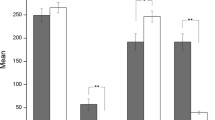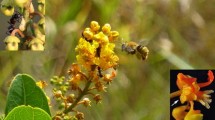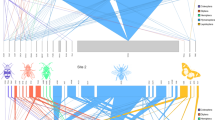Abstract
Plants, herbivores and parasitoids affect each other directly and indirectly; however, feedback effects mediated by host plant traits have rarely been demonstrated in these tritrophic interactions. Brood-site pollination mutualisms (e.g. those involving figs and fig wasps) represent specialised tritrophic communities where the progeny of mutualistic pollinators and of non-mutualistic gallers (both herbivores) together with that of their parasitoids develop within enclosed inflorescences called syconia (hence termed brood-sites or microcosms). Plant reproductive phenology (which affects temporal brood-site availability) and inflorescence size (representing brood-site size) are plant traits that could affect reproductive resources, and hence relationships between trees, pollinators and non-pollinating wasps. Analysing wasp and seed contents of syconia, we examined direct, indirect, trophic and non-trophic relationships within the interaction web of the fig–fig wasp community of Ficus racemosa in the context of brood site size and availability. We demonstrate that in addition to direct resource competition and predator–prey (host–parasitoid) interactions, these communities display exploitative or apparent competition and trait-mediated indirect interactions. Inflorescence size and plant reproductive phenology impacted plant–herbivore and plant–parasitoid associations. These plant traits also influenced herbivore–herbivore and herbivore–parasitoid relationships via indirect effects. Most importantly, we found a reciprocal effect between within-tree reproductive asynchrony and fig wasp progeny abundances per syconium that drives a positive feedback cycle within the system. The impact of a multitrophic feedback cycle within a community built around a mutualistic core highlights the need for a holistic view of plant–herbivore–parasitoid interactions in the community ecology of mutualisms.




Similar content being viewed by others
References
Adler LS, Bronstein JL (2004) Attracting antagonists: does floral nectar increase leaf herbivory? Ecology 85:1519–1526
Al-Beidh S, Dunn DW, Cook JM (2012) Spatial stratification of internally and externally non-pollinating fig wasps and their effects on pollinator and seed abundance in Ficus burkei. ISRN Zool 2012:1–6
Anstett M-C, Bronstein JL, Hossaert-McKey M (1996) Resource allocation: a conflict in the fig/fig wasp mutualism? J Evol Biol 9:417–428
Augspurger CK (1983) Phenology, flowering synchrony, and fruit set of six neotropical shrubs. Biotropica 15:257–267
Borges RM (2015) How to be a fig wasp parasite on the fig–fig wasp mutualism. Curr Opin Insect Sci 8:34–40
Bronstein JL (1989) A mutualism at the edge of its range. Experientia 45:622–637
Callaway RM (2007) Positive interactions and interdependence in plant communities. Springer, Berlin
Chamberlain SA, Rudgers JA (2012) How do plants balance multiple mutualists? correlations among traits for attracting protective bodyguards and pollinators in cotton (Gossypium). Evol Ecol 26:65–77
Colwell RK, Fuentes ER (1975) Experimental studies of the niche. Annu Rev Ecol Syst 6:281–310
Cook JM, Power SA (1996) Effects of within-tree flowering asynchrony on the dynamics of seed and wasp production in an Australian fig species. J Biogeogr 23:487–493
Cook JM, Rasplus J-Y (2003) Mutualists with attitude: coevolving fig wasps and figs. Trends Ecol Evol 18:241–248
Cook JM, Segar ST (2010) Speciation in fig wasps. Ecol Entomol 35:54–66
Crabb BA, Pellmyr O (2006) Impact of the third trophic level in an obligate mutualism: do yucca plants benefit from parasitoids of yucca moths? Int J Plant Sci 167:119–124
Craig TP (2010) The resource regulation hypothesis and positive feedback loops in plant–herbivore interactions. Popul Ecol 52:461–473
Cruaud A, Jabbour-Zahab R, Genson G, Kjellberg F, Kobmoo N, van Noort S, Yang D-Y, Peng Y-Q, Ubaidillah R, Hanson PE et al (2011) Phylogeny and evolution of life-history strategies in the Sycophaginae non-pollinating fig wasps (Hymenoptera, Chalcidoidea). BMC Evol Biol 11:178
Dunn DW, Segar ST, Ridley J, Chan R, Crozier RH, Yu DW, Cook JM (2008) A role for parasites in stabilising the fig-pollinator mutualism. PLoS Biol 6:490–496
Galil J, Eisikowitch D (1968) On the pollination ecology of Ficus sycomorus in East Africa. Ecology 49:259–269
Gates DJ, Nason JD (2012) Flowering asynchrony and mating system effects on reproductive assurance and mutualism persistence in fragmented fig–fig wasp populations. Am J Bot 99:757–768
Ghara M, Ranganathan Y, Krishnan A, Gowda V, Borges RM (2014) Divvying up an incubator: how parasitic and mutualistic fig wasps use space within their nursery microcosm. Arthropod Plant Interact 8:191–203
Gols R, Bukovinszky T, Hemerik L, Harvey JA, Van Lenteren JC, Vet LEM (2005) Reduced foraging efficiency of a parasitoid under habitat complexity: implications for population stability and species coexistence. J Anim Ecol 74:1059–1068
Grace JB, Schoolmaster DR Jr, Guntenspergen GR, Little AM, Mitchell BR, Miller KM, Schweiger EW (2012) Guidelines for a graph-theoretic implementation of structural equation modeling. Ecosphere 3:73
Hayduk LA (1987) Structural equation modeling with LISREL. Johns Hopkins University Press, Baltimore
Holt RD (1977) Predation, apparent competition, and the structure of prey communities. Theor Popul Biol 12:197–229
Hossaert-McKey M, Gibernau M, Frey JE (1994) Chemosensory attraction of fig wasps to substances produced by receptive figs. Entomol Exp Appl 70:185–191
Jandér CK, Herre EA, Simms EL (2012) Precision of host sanctions in the fig tree–fig wasp mutualism: consequences for uncooperative symbionts. Ecol Lett 15:1362–1369
Janzen DH (1979) How to be a fig. Annu Rev Ecol Syst 10:13–51
Johnson SN, Mitchell C, McNicol JW, Thompson J, Karley AJ (2013) Downstairs drivers - root herbivores shape communities of above-ground herbivores and natural enemies via changes in plant nutrients. J Anim Ecol 82:1021–1030
Jöreskog KG, Sörbom D (2012) LISREL 9.1 for Windows [Computer Software]. Scientific Software, Lincolnwood
Krishnan A, Borges RM (2014) Parasites exert conflicting selection pressures to affect reproductive asynchrony of their host plant in an obligate pollination mutualism. J Ecol 102:1329–1340
Krishnan A, Pramanik GK, Revadi SV, Venkateswaran V, Borges RM (2014) High temperatures result in smaller nurseries which lower reproduction of pollinators and parasites in a brood site pollination mutualism. PLoS ONE 9:e115118
Loehlin JC (2013) Latent variable models: an introduction to factor, path, and structural equation analysis. Psychology Press, London
Ode PJ (2006) Plant chemistry and natural enemy fitness: effects on herbivore and natural enemy interactions. Annu Rev Entomol 51:163–185
Ohgushi T (2005) Indirect interaction webs: herbivore-induced effects through trait change in plants. Annu Rev Ecol Evol Syst 36:81–105
Pagès JF, Farina S, Gera A, Arthur R, Romero J, Alcoverro T (2012) Indirect interactions in seagrasses: fish herbivores increase predation risk to sea urchins by modifying plant traits. Funct Ecol 26:1015–1023
Pellmyr O, Leebens-Mack J, Huth CJ (1996) Non-mutualistic yucca moths and their evolutionary consequences. Nature 380:155–156
Peterson BJ, Valentine JF, Heck JL Jr (2013) The snapper–grunt pump: habitat modification and facilitation of the associated benthic plant communities by reef-resident fish. J Expt Mar Biol Ecol 441:50–54
Poelman EH, Dicke M (2014) Plant‐mediated interactions among insects within a community ecological perspective. In: Voelckel C, Jander G (eds) Annual plant reviews. Insect plant interactions, vol 47. Wiley, New York, pp 309–338
Price PW, Bouton CE, Gross P, McPheron BA, Thompson JN, Weis AE (1980) Interactions among three trophic levels: influence of plants on interactions between insect herbivores and natural enemies. Annu Rev Ecol Syst 11:41–65
Proffit M, Schatz B, Borges RM, Hossaert-Mckey M (2007) Chemical mediation and niche partitioning in non-pollinating fig-wasp communities. J Anim Ecol 76:296–303
Randlkofer B, Obermaier E, Hilker M, Meiners T (2010) Vegetation complexity—The influence of plant species diversity and plant structures on plant chemical complexity and arthropods. Basic Appl Ecol 11:383–395
Ranganathan Y, Ghara M, Borges RM (2010) Temporal associations in fig–wasp–ant interactions: diel and phenological patterns. Entomol Exp Appl 137:50–61
Savage AM, Peterson MA (2007) Mutualism in a community context: the positive feedback between an ant–aphid mutualism and a gall-making midge. Oecologia 151:280–291
Schöb C, Callaway RM, Anthelme F, Brooker RW, Cavieres LA, Kikvidze Z, Lortie CJ, Michalet R, Pugnaire FI, Xiao S, Cranston BH, García M-C, Hupp NR, Llambí LD, Lingua E, Reid AM, Zhao L, Butterfield BJ (2014) The context dependence of beneficiary feedback effects on benefactors in plant facilitation. New Phytol 204:386–396
Segar ST, Lopez-Vaamonde C, Rasplus J-Y, Cook JM (2012) The global phylogeny of the subfamily Sycoryctinae (Pteromalidae): parasites of an obligate mutualism. Mol Phylogenet Evol 65:116–125
Segar ST, Pereira RA, Compton SG, Cook JM (2013) Convergent structure of multitrophic communities over three continents. Ecol Lett 16:1436–1445
Taylor AD (1988) Parasitoid competition and the dynamics of host-parasitoid models. Am Nat 132:417–436
Verdú M, Valiente-Banuet A (2008) The nested assembly of plant facilitation networks prevents species extinctions. Am Nat 172:751–760
Wajnberg É (2006) Time allocation strategies in insect parasitoids: from ultimate predictions to proximate behavioral mechanisms. Behav Ecol Sociobiol 60:589–611
Walde SJ, Murdoch WW (1988) Spatial density dependence in parasitoids. Annu Rev Entomol 33:441–466
Wang RW, Shi L, Ai SM, Zheng Q (2008) Trade-off between reciprocal mutualists: local resource availability-oriented interaction in fig/fig wasp mutualism. J Anim Ecol 77:616–623
Wang R-W, Sun B-F, Zheng Q (2010) Diffusive coevolution and mutualism maintenance mechanisms in a fig–fig wasp system. Ecology 91:1308–1316
Wootton JT (1994) The nature and consequences of indirect effects in ecological communities. Annu Rev Ecol Syst 25:443–466
Wright S (1934) The method of path coefficients. Ann Math Stat 5:161–215
Acknowledgments
We thank R. Yettiraj, Pratibha Yadav and Yuvaraj Ranganathan for help in bagging and fig collection, as well as Doyle McKey, Lawrence Harder, Carol Horvitz, Vignesh Venkateswaran, Lakshy Katariya, Joyshree Chanam and two anonymous reviewers for valuable suggestions on the manuscript. This research was funded by the Ministry of Environment, Forests & Climate Change, and the Department of Biotechnology, Government of India.
Conflict of interest
The authors declare that they have no conflict of interest.
Author information
Authors and Affiliations
Corresponding author
Additional information
Communicated by Caroline Müller.
Electronic supplementary material
Below is the link to the electronic supplementary material.
Rights and permissions
About this article
Cite this article
Krishnan, A., Ghara, M., Kasinathan, S. et al. Plant reproductive traits mediate tritrophic feedback effects within an obligate brood-site pollination mutualism. Oecologia 179, 797–809 (2015). https://doi.org/10.1007/s00442-015-3372-9
Received:
Accepted:
Published:
Issue Date:
DOI: https://doi.org/10.1007/s00442-015-3372-9




